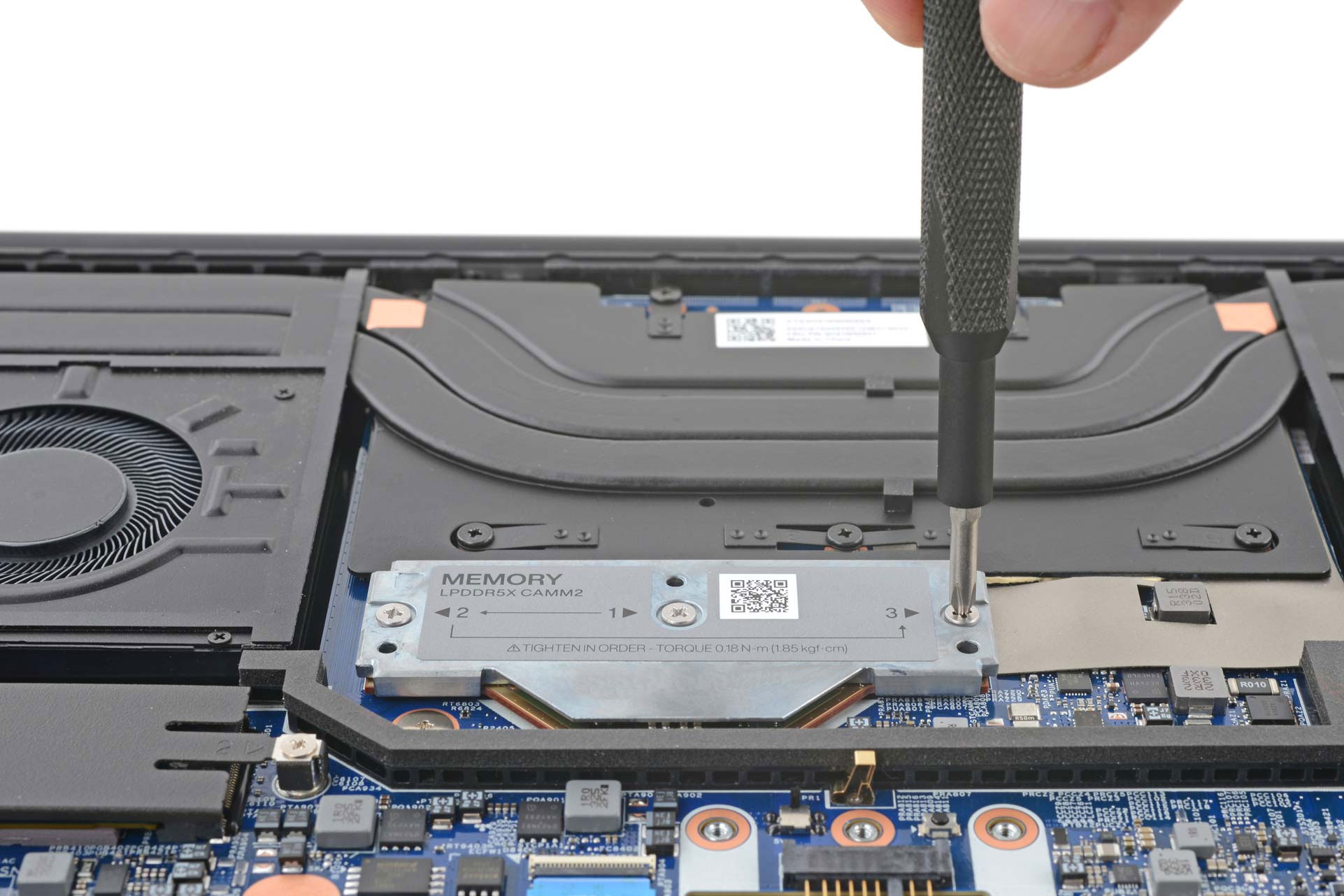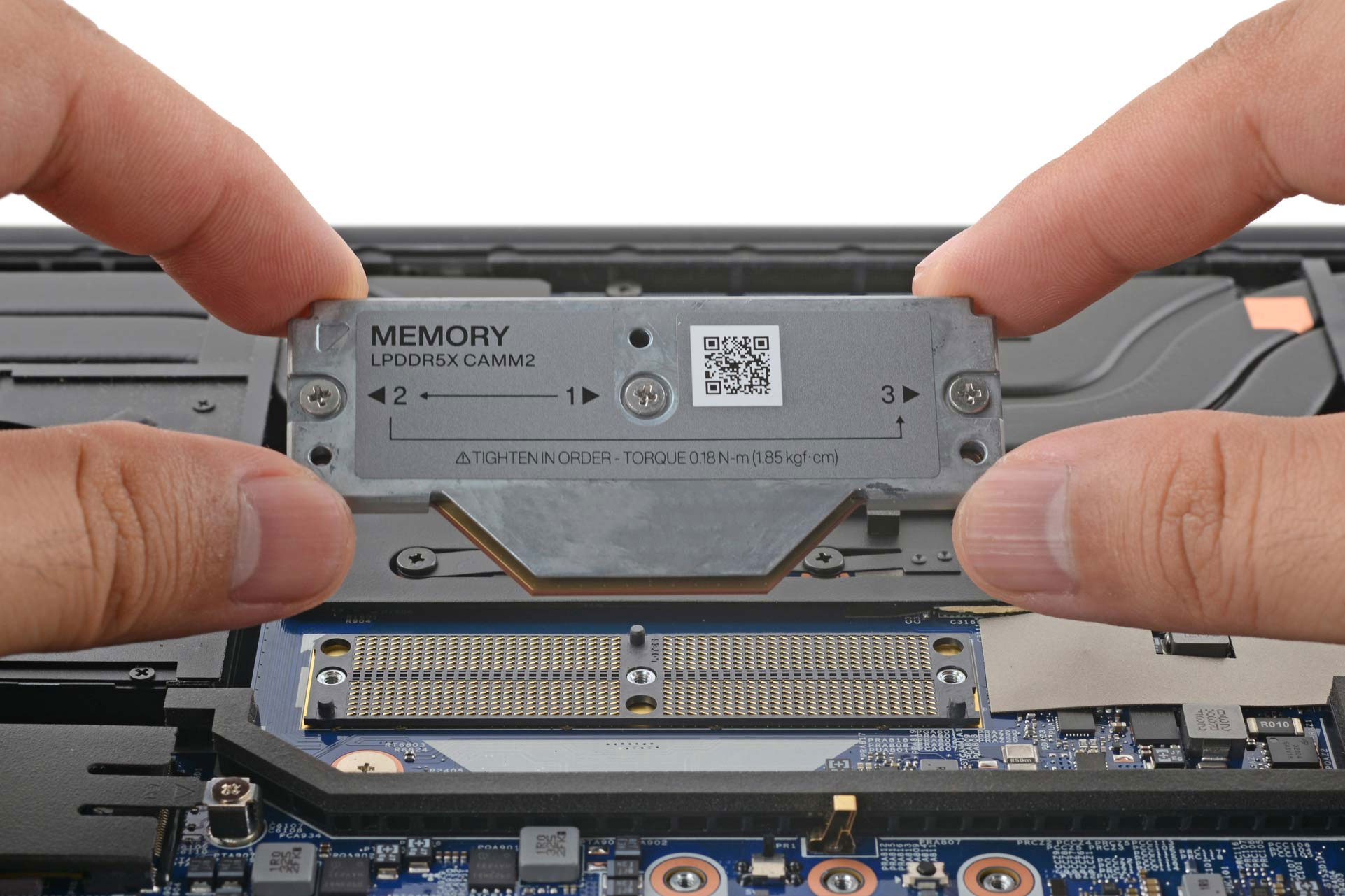Lenovo launches ThinkPad P1 (Gen 7): The first laptop with LPCAMM2 memory
The Lenovo ThinkPad P1 (Gen 7), uses LPDDR5X memory in an LPCAMM2 module that users can upgrade or replace by removing screws from the laptop's motherboard.
That's a big change from the LPDDR memory currently found in most modern laptops. This type of memory is usually soldered to the motherboard, making upgrades much more difficult. LPCAMM2 - or Low-Power Compression-Attached Memory Module - provides modularity without sacrificing the power efficiency of LPDDR.


Traditional DDR RAM uses SODIMM sticks that plug into the motherboard, just like on a desktop. As iFixit points out, LPDDR is much more power efficient, but it needs to be soldered directly to the mainboard, as close to the processor as possible. Until now, manufacturers have had to choose between upgradeable RAM and power-efficient RAM. LPCAMM2 tries to balance both factors by fastening it to the motherboard with screws instead of solder. And unlike SODIMM bars, each LPCAMM2 module is dual channel, so just one module is enough.
As shown in the hands-on video posted by iFixit, the LPCAMM2 in Lenovo's new ThinkPad P1 can be replaced by removing the back of the laptop and then removing the battery. From there, the LPCAMM2 can be removed by removing the 3 Phillips head screws.
In addition to Micron, Samsung and ADATA are also participating in LPCAMM2. Hopefully that will help users easily upgrade their memory in the future.
You should read it
- Lenovo ThinkPad Helix 2 with Core M Broadwell chip on the shelf
- Lenovo introduces new ThinkPad series, X1 Carbon gen 3, ThinkVision X24 and ThinkPad Stack
- Review Lenovo ThinkPad X1 Carbon Gen 8: The best business laptop
- Review Lenovo ThinkPad X390: Excellent business laptop
- The ultra-thin Lenovo ThinkPad X1 is coming soon
- Thinkpad T413s and X230s leaked on Lenovo homepage
- Lenovo launched 2 laptops priced from 21-30 million VND
- Lenovo launches three new ThinkPad T, X and L series with many notable advantages
May be interested
- Laptop Lenovo: 'Still' and 'will' is ... Thinkpad!
 2 years after acquiring ibm's pc division, lenovo's latest laptop product lines show that all the unique inventions in the ibm thinkpad line of popular computers continue to be developed.
2 years after acquiring ibm's pc division, lenovo's latest laptop product lines show that all the unique inventions in the ibm thinkpad line of popular computers continue to be developed. - Lenovo revealed the ThinkPad S3 and S5 duo with aluminum frame design
 lenovo has just revealed that it will soon launch two new mass-market laptops with a beautiful aluminum frame design called lenovo thinkpad s3 and s5.
lenovo has just revealed that it will soon launch two new mass-market laptops with a beautiful aluminum frame design called lenovo thinkpad s3 and s5. - Lenovo sells ThinkPad computers for students
 the thinkpad x131e is 11.6 inches in size with the choice of an amd e-series processor or an intel celeron or core i3.
the thinkpad x131e is 11.6 inches in size with the choice of an amd e-series processor or an intel celeron or core i3. - Lenovo introduces new ThinkPad series, X1 Carbon gen 3, ThinkVision X24 and ThinkPad Stack
 lenovo has just unveiled the latest series of thinkpad products before the ces 2015 exhibition. among these products are notable is the third generation thinkpad x1 carbon laptop with a weight of only about 1 kg, light most in the entrepreneur ultrabook segment. the other new products include a thinkvision x24 screen, a versatile thinkpad stack system and 7 other thinkpad ultrabook models for $ 599 to $ 1149.
lenovo has just unveiled the latest series of thinkpad products before the ces 2015 exhibition. among these products are notable is the third generation thinkpad x1 carbon laptop with a weight of only about 1 kg, light most in the entrepreneur ultrabook segment. the other new products include a thinkvision x24 screen, a versatile thinkpad stack system and 7 other thinkpad ultrabook models for $ 599 to $ 1149. - Lenovo revealed a cheap ThinkPad laptop
 lenovo will unveil its new popular thinkpak line with a better design and easier keyboard for users to use.
lenovo will unveil its new popular thinkpak line with a better design and easier keyboard for users to use. - Review Lenovo ThinkPad X1 Carbon Gen 8: The best business laptop
 lenovo's thinkpad x1 carbon gen 8 brings a new design with a few interesting additions. a few adjustments will make this model more attractive than ever for business users, as well as everyday users.
lenovo's thinkpad x1 carbon gen 8 brings a new design with a few interesting additions. a few adjustments will make this model more attractive than ever for business users, as well as everyday users. - Lenovo launches a voice chat computer
 lenovo has just introduced new thinkpad yoga products aimed at business users. the product has a powerful configuration, handy and special hybrid design that can 'chat' with voice.
lenovo has just introduced new thinkpad yoga products aimed at business users. the product has a powerful configuration, handy and special hybrid design that can 'chat' with voice. - ThinkPad Helix will be shipped in early March
 after announcing a delay in its launch date in february, lenovo recently said it is trying to put the latest hybrid laptop on sale in early march.
after announcing a delay in its launch date in february, lenovo recently said it is trying to put the latest hybrid laptop on sale in early march. - Lenovo launched 2 laptops priced from 21-30 million VND
 both lenovo's thinkpad x230 and thinkpad t430 laptops, which were launched on september 4, 2012, are designed specifically for mobile needs so they are not affordable.
both lenovo's thinkpad x230 and thinkpad t430 laptops, which were launched on september 4, 2012, are designed specifically for mobile needs so they are not affordable. - Lenovo is about to launch its first Linux laptop model
 lenovo will also follow dell to launch a series of brand new linux laptops in the near future.
lenovo will also follow dell to launch a series of brand new linux laptops in the near future.










 Huawei's new laptop 'makes waves' in US politics
Huawei's new laptop 'makes waves' in US politics 5 Simplest and fastest ways to restart your Laptop
5 Simplest and fastest ways to restart your Laptop 10 most effective ways to save laptop battery
10 most effective ways to save laptop battery How to turn on Laptop keyboard light easily
How to turn on Laptop keyboard light easily How to fix Laptop with no sound, Laptop with no sound
How to fix Laptop with no sound, Laptop with no sound Laptop screen won't turn on - Cause & fix
Laptop screen won't turn on - Cause & fix